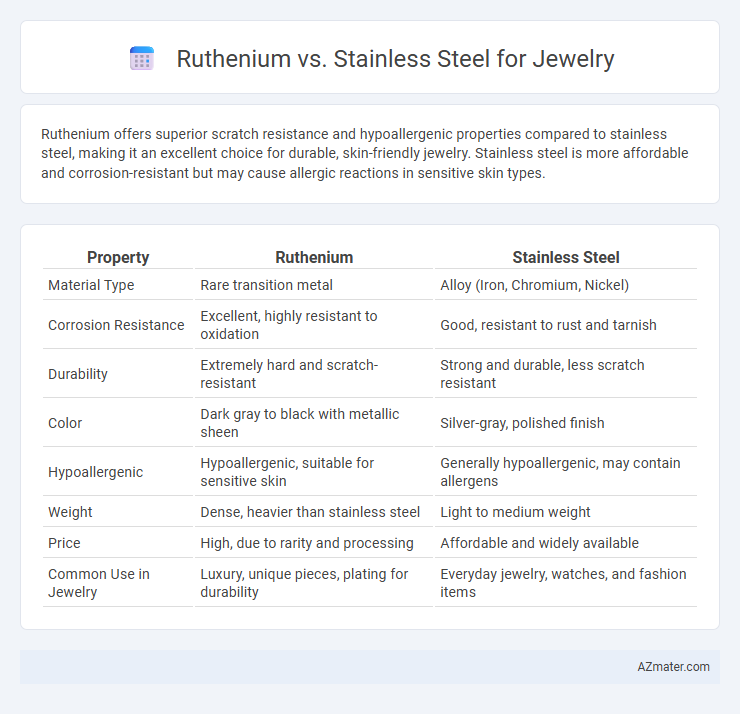Ruthenium offers superior scratch resistance and hypoallergenic properties compared to stainless steel, making it an excellent choice for durable, skin-friendly jewelry. Stainless steel is more affordable and corrosion-resistant but may cause allergic reactions in sensitive skin types.
Table of Comparison
| Property | Ruthenium | Stainless Steel |
|---|---|---|
| Material Type | Rare transition metal | Alloy (Iron, Chromium, Nickel) |
| Corrosion Resistance | Excellent, highly resistant to oxidation | Good, resistant to rust and tarnish |
| Durability | Extremely hard and scratch-resistant | Strong and durable, less scratch resistant |
| Color | Dark gray to black with metallic sheen | Silver-gray, polished finish |
| Hypoallergenic | Hypoallergenic, suitable for sensitive skin | Generally hypoallergenic, may contain allergens |
| Weight | Dense, heavier than stainless steel | Light to medium weight |
| Price | High, due to rarity and processing | Affordable and widely available |
| Common Use in Jewelry | Luxury, unique pieces, plating for durability | Everyday jewelry, watches, and fashion items |
Introduction to Ruthenium and Stainless Steel in Jewelry
Ruthenium, a rare transition metal in the platinum group, is prized in jewelry for its durability, scratch resistance, and unique dark gray to black finish, offering a modern twist on traditional precious metals. Stainless steel, an alloy primarily composed of iron, chromium, and nickel, is favored for its corrosion resistance, strength, and affordability, making it a popular choice in contemporary jewelry applications. Both materials provide hypoallergenic properties and maintain their appearance over time, appealing to consumers seeking long-lasting and low-maintenance jewelry options.
Physical Properties Comparison
Ruthenium exhibits higher hardness and scratch resistance compared to stainless steel, making it ideal for durable jewelry that maintains its finish over time. Stainless steel offers superior corrosion resistance and tensile strength, providing robust jewelry that withstands daily wear and exposure to moisture. Ruthenium's higher density results in a noticeably heavier feel, while stainless steel is lighter and more affordable, influencing design choices based on comfort and budget.
Aesthetic Differences and Finishes
Ruthenium offers a dark, gunmetal-gray finish that provides a unique, modern aesthetic compared to the bright, reflective shine of stainless steel. Its natural resistance to tarnish allows for long-lasting, matte or satin finishes that retain their appearance without frequent polishing. Stainless steel, however, excels in producing highly polished, mirror-like surfaces that emphasize brilliance and classic metallic luster.
Durability and Wear Resistance
Ruthenium offers exceptional durability and wear resistance, making it highly resistant to scratches, tarnish, and corrosion compared to traditional stainless steel. This rare metal maintains its luster longer under daily wear conditions, ideal for fine jewelry pieces that require minimal maintenance. Stainless steel, while durable and corrosion-resistant, tends to show wear over time through scratches and slight discoloration, making ruthenium a superior choice for long-lasting, high-end jewelry.
Hypoallergenic Qualities and Skin Safety
Ruthenium is a rare, hypoallergenic metal often used as a durable coating over other metals to enhance skin safety, making it ideal for sensitive skin due to its resistance to tarnishing and corrosion. Stainless steel, particularly surgical-grade 316L, is widely recognized for its hypoallergenic properties and affordability, providing excellent resistance to rust and irritation. Both materials offer safe options for jewelry wearers prone to allergies, with ruthenium coatings offering an extra layer of protection against skin reactions.
Maintenance and Care Requirements
Ruthenium jewelry requires minimal maintenance due to its high resistance to tarnish, scratches, and corrosion, making it ideal for everyday wear without frequent cleaning. Stainless steel also offers excellent durability and corrosion resistance but may accumulate minor surface scratches over time that require occasional polishing. Both metals are hypoallergenic, but ruthenium's harder surface demands less upkeep compared to stainless steel, which benefits from regular cleaning with mild soap and water to maintain its shine.
Cost and Market Value
Ruthenium offers a unique, lustrous finish that enhances jewelry pieces while maintaining higher market value due to its rarity and durability compared to stainless steel. Stainless steel is widely used for its affordability and resistance to tarnish, making it a cost-effective choice but with lower intrinsic value. The premium price of ruthenium jewelry reflects its scarcity and platinum-group metal status, attracting collectors seeking exclusive and durable accessories.
Design Versatility and Customization
Ruthenium offers exceptional design versatility for jewelry with its dark metallic sheen and excellent durability, allowing intricate and modern designs to stand out with a unique, luxurious finish. Stainless steel provides a wide range of customization options due to its affordability and ability to be easily shaped, engraved, and plated in various colors, making it ideal for personalized and budget-friendly pieces. Both metals support diverse aesthetics, but ruthenium's premium look attracts high-end designs, while stainless steel excels in mass production and custom engraving.
Environmental Impact and Sustainability
Ruthenium is a rare platinum-group metal often used as a durable coating in jewelry, offering high corrosion resistance and reducing the need for frequent replacements, which contributes to sustainability. Stainless steel, composed primarily of iron, chromium, and nickel, is highly recyclable and widely available, making it an eco-friendly option with lower mining impacts compared to precious metals. However, ruthenium's limited supply and energy-intensive extraction process result in a higher environmental footprint than stainless steel, despite its longevity in jewelry applications.
Choosing the Right Metal for Your Jewelry Needs
Ruthenium offers exceptional durability and a unique dark gray finish that resists tarnish, making it ideal for modern, low-maintenance jewelry. Stainless steel provides strength, corrosion resistance, and affordability while maintaining a classic silver-tone appearance suitable for everyday wear. Selecting the right metal depends on balancing aesthetic preference, budget, and long-term wearability for a personalized jewelry experience.

Infographic: Ruthenium vs Stainless Steel for Jewelry
 azmater.com
azmater.com